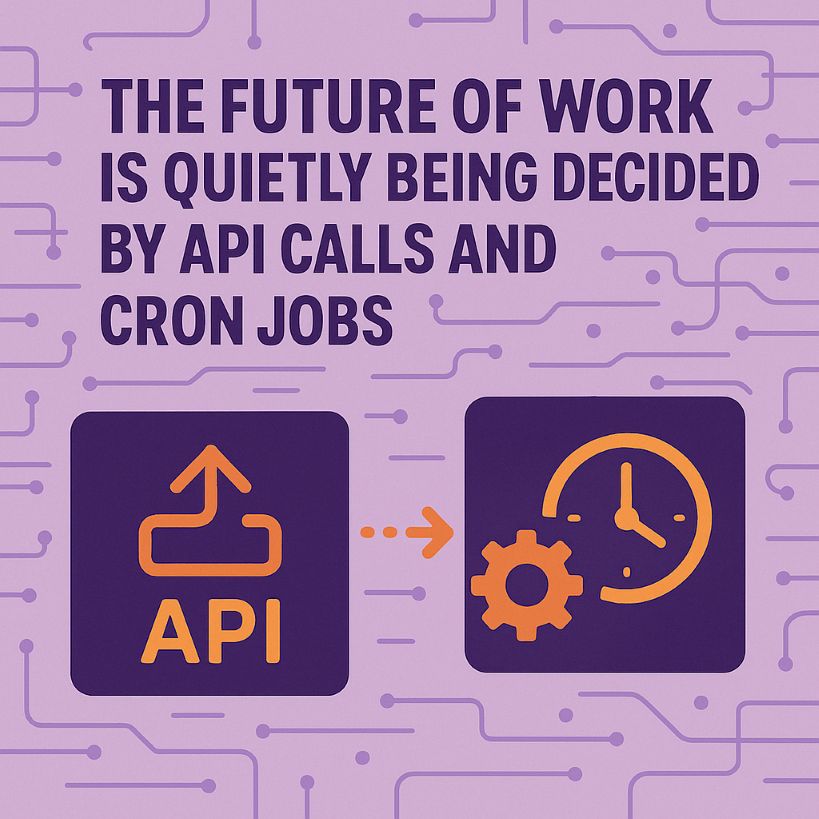While executives debate AI strategy in boardrooms and pundits speculate about mass unemployment, the real transformation of work is happening in the shadows—one API endpoint at a time, one scheduled script at a time. The future isn’t being architected by grand pronouncements or billion-dollar acquisitions. It’s being quietly assembled by developers connecting services, automating workflows, and writing code that runs at 3 AM when no one’s watching.
The Invisible Infrastructure of Change
Every morning, millions of workers wake up to find their tasks have shifted slightly. A spreadsheet that used to require manual updates now refreshes automatically. Customer inquiries that once demanded human triage are pre-sorted by sentiment analysis. Expense reports that consumed Friday afternoons now process themselves through OCR and approval workflows.
These aren’t headline-grabbing transformations. They’re the accumulation of thousands of small automations, each one a simple API call or scheduled job that removes friction from human work. A developer connects Slack to Jira. Another pipes CRM data into analytics dashboards. Someone writes a script that monitors server health and auto-scales resources. Individually, these changes seem trivial. Collectively, they’re rewiring how work gets done.
The Power of Plumbing
The most profound workplace changes often come disguised as mundane technical improvements. When Stripe simplified online payments with a few lines of code, it didn’t just make transactions easier—it enabled entire business models that couldn’t exist before. When Twilio turned SMS into an API call, it transformed customer communication from a telecom service into a programmable medium.
This pattern repeats across every industry. Healthcare workers spend less time on paperwork because APIs connect electronic health records to billing systems. Logistics companies optimize routes in real-time because GPS data flows seamlessly into planning algorithms. Marketing teams launch campaigns faster because customer data automatically syncs between platforms.
The common thread isn’t artificial intelligence or machine learning—it’s the simple power of systems talking to each other without human intervention.
Cron Jobs: The Unsung Heroes of Productivity

At 2:30 AM every Tuesday, a cron job runs at a mid-sized accounting firm. It reconciles transactions across three different banking APIs, flags discrepancies, and queues them for review. By the time accountants arrive at 9 AM, routine reconciliation work that once consumed entire mornings is reduced to handling exceptions.
This story plays out in countless variations across the economy. Inventory systems that reorder supplies when stock runs low. Email campaigns that trigger based on customer behavior. Reports that generate and distribute themselves before anyone asks for them. Social media posts that schedule across platforms at optimal engagement times.
These aren’t sophisticated AI systems making complex decisions. They’re simple, reliable automations handling predictable tasks. Yet their cumulative impact on human productivity is staggering.
The API Economy Reshapes Skill Demands
As more work becomes a matter of orchestrating systems rather than managing information, the skills that matter are changing. The ability to connect disparate services becomes more valuable than mastery of any single platform. Understanding data flows matters more than data entry speed. Writing automation scripts becomes as important as writing reports.
This shift is particularly visible in how job roles are evolving. Marketing managers who can set up webhook integrations between their email platform and CRM become force multipliers for their teams. Operations managers who automate routine processes with no-code tools create capacity for strategic work. Even traditionally non-technical roles increasingly require comfort with APIs, automation platforms, and basic scripting.
The winners in this transformation aren’t necessarily the most technically sophisticated. They’re the ones who recognize that every manual, repetitive task is an automation opportunity waiting to happen.
Beyond Efficiency: Creating New Forms of Work
The deeper impact of API-driven automation isn’t just doing existing work faster—it’s enabling entirely new types of work that couldn’t scale manually. Customer success teams can now provide personalized onboarding experiences to thousands of users simultaneously through automated email sequences triggered by usage data. Sales teams can nurture leads with precision timing based on behavioral signals from multiple touchpoints.
These new workflows require human creativity and strategy, but their execution relies entirely on systems talking to each other. The human role shifts from executing tasks to designing systems that execute tasks.
Building the Rails for AI

Here’s what most AI discussions miss: the current wave of API-driven automation isn’t just changing work—it’s building the infrastructure that makes AI integration inevitable and seamless. Every webhook, every data pipeline, every automated workflow is laying track for more sophisticated AI tools to run on.
Consider what happens when a company has already automated data collection from customer interactions, synchronized it across platforms, and established reliable pipelines for processing that information. When AI tools become sophisticated enough to analyze customer sentiment, predict churn, or generate personalized responses, the integration becomes trivial. The data flows are already established. The automation framework already exists. Adding AI capabilities becomes as simple as swapping out one API endpoint for another.
This is why companies with mature automation infrastructures will have massive advantages in AI adoption. They’re not starting from scratch—they’re plugging AI into existing workflows that already handle data collection, processing, and distribution automatically.
The Quiet Revolution Continues
While public attention focuses on ChatGPT and autonomous vehicles, the most significant workplace transformation is happening through incremental automation. Every new SaaS integration, every webhook configuration, every scheduled data sync makes human work a little more strategic and a little less routine.
This infrastructure-first approach to automation is creating the perfect conditions for AI tools to slot seamlessly into existing workflows. When AI can analyze documents, the companies already automatically routing and categorizing documents will benefit first. When AI can write code, the teams already automating deployments and testing will see immediate productivity gains.
The dramatic disruption often predicted for AI and automation may indeed be coming—but it will arrive through these existing automation channels, not as a separate revolution. The companies building robust API integrations today are essentially constructing the nervous system that AI will eventually inhabit.
The future of work isn’t being decided in Silicon Valley conference rooms or government policy meetings. It’s being written in Python scripts, configured in automation platforms, and deployed through API calls. The developers connecting these systems may not realize they’re reshaping the economy, but that’s exactly what’s happening—one cron job at a time.
What This Means for Workers and AI Readiness
For individual workers, the message is clear: the most career-resilient skill isn’t expertise in any particular tool or platform. It’s the ability to identify automation opportunities and either implement them yourself or work effectively with those who can. Understanding how systems connect and data flows between them becomes as fundamental as traditional computer literacy once was.
But there’s a deeper implication. Workers who understand automation workflows will be best positioned to leverage AI tools when they mature. If you know how to set up a webhook that processes customer emails, you’ll quickly grasp how to integrate an AI service that can understand and respond to those emails intelligently. If you’re comfortable with API integrations today, you’ll be ready to orchestrate AI capabilities tomorrow.
The future belongs to those who can orchestrate the orchestra of APIs—and increasingly, that orchestra will include AI musicians playing alongside traditional automation instruments. The foundation being laid by today’s cron jobs and API calls isn’t just changing current work; it’s preparing the infrastructure for an AI-augmented workplace that can scale human capabilities rather than simply replacing human tasks.


Leave a Reply
You must be logged in to post a comment.